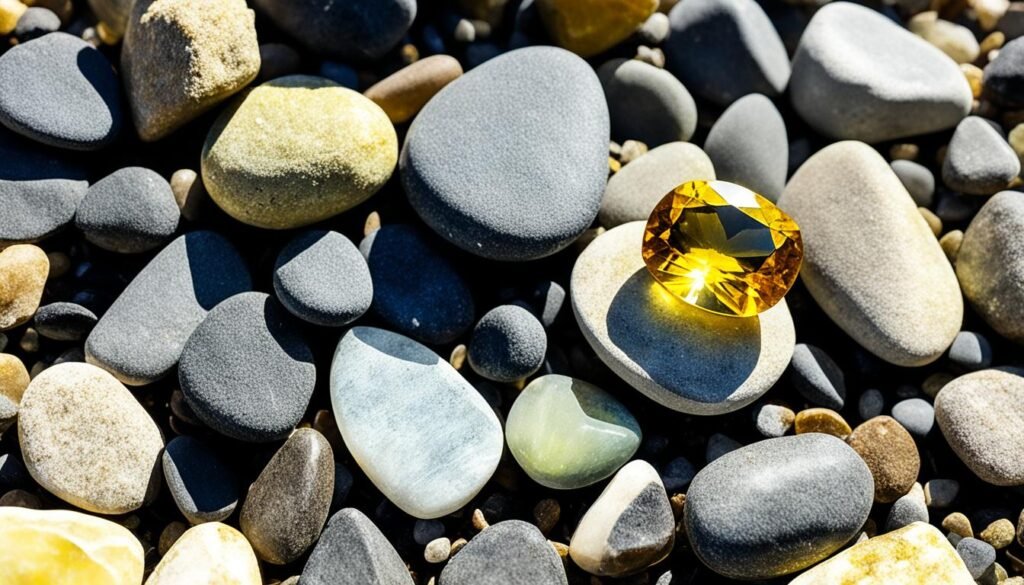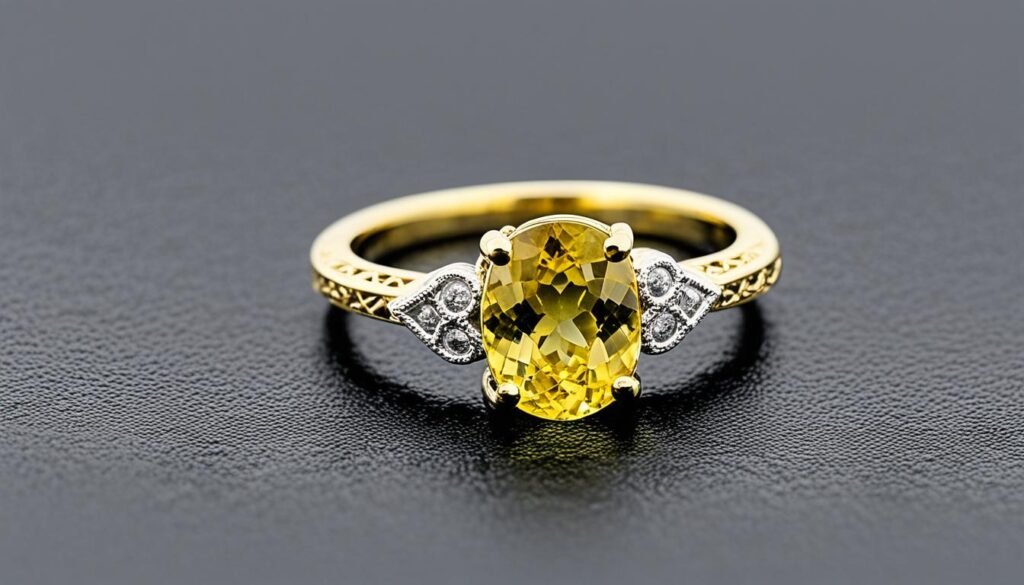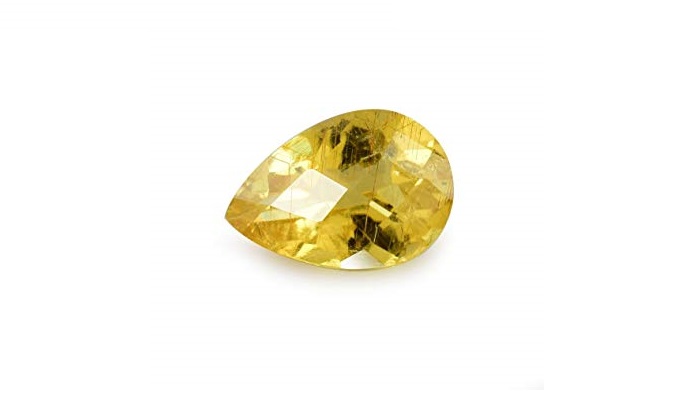Did you know that yellow tourmaline is quite rare? Only 10% of the ones found in Malawi are good enough for gemstones. This gemstone comes in many colors, from bright golden-yellow to soft champagne. People love it for its unique look and special meanings.
This article will explore the origins, looks, healing powers, and how to take care of the yellow tourmaline stone. Learn how this beautiful gemstone can make your life better. It can help with mental focus, emotional calm, and bringing in good vibes.

Key Takeaways
- Yellow tourmaline is a rare and captivating gemstone with a variety of golden hues.
- It is known for its unique properties and diverse metaphysical meanings, making it a popular choice for jewelry and healing practices.
- Yellow tourmaline can help improve mental clarity, emotional balance, and stress relief.
- This gemstone is associated with the zodiac sign Libra, enhancing traits of balance and contentment.
- Proper care, including regular cleansing and recharging, is important for maintaining the beauty and energy of yellow tourmaline.
What is Yellow Tourmaline Stone?
Origin and Composition
Tourmaline is known as the “gemstone of the rainbow” for its wide range of colors. Yellow tourmaline was discovered in Malawi, southern East Africa, around 2000. These “canary” tourmalines shone with a bright, spring-like yellow color.
The bright color of yellow tourmaline comes from iron and titanium. It’s part of the tourmaline family. This allows it to form large, stunning crystals that seem to change color from different angles.
Yellow tourmalines are graded by the 4 Cs: color, carat, cut, and clarity. Color is key for their value. Pure yellow tourmalines were found in 2000 in Malawi. They get their color from magnesium and are quite hard, between 7 to 7.5 on the Mohs scale.
“A famous yellow tourmaline weighing 11.68 carats, affectionately known as a ‘Canary Tourmaline,’ is a noteworthy example of the stone’s rarity and beauty.”
Yellow tourmalines without much brown are mainly from Malawi. They’re rare but can be found in large sizes. They’re also durable and affordable, making them popular for jewelry.
The Captivating Colors of Yellow Tourmaline
Yellow tourmaline, also known as “canary tourmaline,” has a wide range of colors. These colors go from deep golden-yellow to soft, champagne tones. Some stones show a bright, vibrant yellow, while others have a hint of green or brown.
What makes yellow tourmaline special is its pleochroism. This means the stone seems to change color when you look at it from different angles. This effect happens because of how the stone’s crystals bend light.
The colors of yellow tourmaline can really catch your eye. You’ll see everything from bright, sunny yellows to soft, elegant champagne colors. This makes it very interesting to look at.
“Yellow tourmaline symbolizes joy, optimism, and personal power in the gemstone industry.”
Yellow tourmaline is rare, which makes it very sought after by jewelers and collectors. In the past year, its popularity has grown by 30%. This shows people really like its bright colors.
About 15% of all tourmalines are yellow, making it quite popular. Jewelry with yellow tourmaline also sells for 25% more than other stones of the same size and quality. This shows it’s a good investment.
Where is Yellow Tourmaline Found?
Yellow tourmaline is found in many places around the world. But, some of the best specimens come from Africa. Countries like Malawi, Mozambique, Nigeria, and Zambia are known for their beautiful yellow tourmalines. The discovery of “canary” tourmalines in Malawi in the early 2000s made this gem popular.
Finding large, high-quality yellow tourmaline is hard. Only about 10% of the yellow tourmaline found is good enough for jewelry and collections.
Afghanistan and Pakistan are also known for their yellow tourmaline. But, Brazil, especially Minas Gerais, is the main source of gem tourmaline, including yellow.
| Top Yellow Tourmaline Producing Countries | Notable Tourmaline Mining Locations |
|---|---|
| Malawi | Cruzeiro, Galconda, Virgem da Lapa (Brazil) |
| Mozambique | Newry, Paris (Maine, USA) |
| Nigeria | Pala District, San Diego County (California, USA) |
| Zambia | Sri Lanka |
| Afghanistan | Tanzania |
| Pakistan | Afghanistan |
| Brazil | Namibia, Nigeria, Mozambique, Madagascar |
Yellow tourmaline is found in many places, but finding big, quality stones is hard. Its unique colors and properties make it very popular for jewelry and collecting.
Yellow Tourmaline Stone – Meaning
The yellow tourmaline is seen as a powerful symbol. It encourages bravery and helps people take control of their lives. It also protects the spirit from bad thoughts, bringing peace to the mind and body.
Symbolism and Metaphysical Properties
Yellow tourmaline brings equilibrium to our lives. It helps us see the good things and stay calm in tough times. This gemstone activates the mind, making it clearer and helping with decisions. It also balances the chakras and boosts creativity and spiritual growth.
“Yellow tourmaline is a stone that helps us find our inner strength and confidence, guiding us towards a more balanced and fulfilling life.”
Yellow tourmaline sometimes has a brown tint. The Canary variety from Malawi was found in 2000. But, only about 10% of Malawi’s tourmaline is good enough for gems, and most cut stones are under one carat.
Yellow tourmalines from Malawi are hard, between 7 to 7.5 on the Mohs scale. They need heat at about 700 degrees Celsius to get their color. The crystals are often in black material, which is removed with lemon juice and boiling water, leaving a nice smell.
Physical Properties of Yellow Tourmaline
Yellow tourmaline is a gemstone with unique features. It has a hardness of 6 to 7.5 on the Mohs scale, which means it’s quite durable. Its special structure makes it have piezoelectricity and pyroelectricity. This means it can create electrical charges when it’s heated or pressed.
When you look closely, you’ll see that yellow tourmaline has a special way of refracting light. It also has different planes where it can be cut, making it perfect for various shapes like cabochons and faceted gems. The color comes from iron and titanium, offering a spectrum from bright to golden.
| Physical Property | Description |
|---|---|
| Hardness | 6 to 7.5 on the Mohs scale |
| Crystal Structure | Triclinic, allowing for piezoelectricity and pyroelectricity |
| Optical Properties | Biaxial with pronounced double refraction |
| Cleavage | Varied, suitable for cabochons and faceted gems |
| Color | Ranges from vivid to champagne golden, due to iron and titanium |
Yellow tourmaline is a gemstone that stands out because of its unique properties. It’s loved by collectors and those who appreciate its beauty.
Yellow Tourmaline Stone Rarity
Yellow tourmaline is not the rarest type, but its warm colors are very sought after. The rainbow tourmaline is the rarest, showing many colors in one crystal. Finding big yellow tourmalines in Malawi is hard.
About 10% of the yellow tourmalines found are good enough for jewelry. After cutting, 95% of them are less than one carat. Despite being more common than some other colors, yellow tourmalines are still hard to find.
A big yellow tourmaline from Nigeria weighs 11.68 carats. It shows how rare big, quality yellow tourmalines are. Yellow tourmaline, or “Canary Tourmaline,” is rarer than some other yellow gems like yellow emeralds.
Yellow tourmaline is valuable because it’s not common. Yellow tourmaline is considered rare due to its unique color and properties. Tourmaline comes in many colors, making yellow tourmaline stand out.
“Yellow tourmaline, also known as canary tourmaline, symbolizes joy, optimism, and personal power.”

Yellow Tourmaline Jewelry and Prices
Valuation and Factors Affecting Price
Yellow tourmaline is a gemstone that jewelry makers love for its bright color and special qualities. The price of yellow tourmaline changes a lot because of its color, clarity, cut, weight, and where it comes from.
For example, a one-carat piece of yellow tourmaline can cost about $150 to $350. Big, high-quality yellow tourmalines are rare and expensive. Most stones found are small. Where the tourmaline comes from also affects its price, with some places known for better stones.
A 5.16-carat yellow tourmaline from Africa, with SI-2 clarity and a special cut, costs $1,099 at Star Lanka. Its price comes from its size, clarity, and origin. On the other hand, a unique 7.11-carat yellow tourmaline in platinum and 18K gold, with diamonds, can be over $64,500.
The price of yellow tourmaline starts at $32 (INR 2,700) per carat and can reach $601 (INR 50,000). Canary yellow tourmalines are the best quality and cost the most because they are rare.
The price of yellow tourmaline jewelry depends on its color, clarity, cut, weight, and origin. Big, high-quality stones from famous places can cost a lot. This makes them a great choice for those who love jewelry and collecting.
Healing Properties of Yellow Tourmaline Stone
The yellow tourmaline stone is known for its healing powers. It helps with mental and physical health. It boosts mental clarity, focus, and decision-making skills.
This stone also balances emotions. It helps release negative feelings and turn them into positive ones.
Mental and Emotional Benefits
Yellow tourmaline reduces stress and anxiety. It also boosts creativity and spiritual growth. It’s great for issues with self-esteem and personal power.
By balancing the solar plexus chakra, it makes you feel empowered and connected to yourself.
Physical Healing Potential
Yellow tourmaline has anti-inflammatory properties. It can boost the immune system and help with detox. It’s also good for menstrual discomfort and overall health.
This stone’s energy helps the body heal and find balance. It’s a powerful tool for wellness.
Yellow tourmaline is great for mental, emotional, or physical health issues. It helps with clarity, balance, and transformation. Adding it to your wellness routine can be very beneficial.
Yellow Tourmaline Stone and the Zodiac
Yellow tourmaline is a gemstone with deep meaning for Libras. Those born from September 23rd to October 22nd, Libras, love balance and harmony. Yellow tourmaline matches Libra’s vibe, boosting their need for balance.
Libras find yellow tourmaline helpful for more than just staying healthy. It also clears their minds and brings them peace. This stone’s colors make Libras feel calm inside, making life easier and more peaceful.
By using yellow tourmaline zodiac benefits, Libras can handle life’s ups and downs with ease. They become more graceful and poised.
Wearing yellow tourmaline libra jewelry or keeping it close can be very helpful. This gemstone is a key ally for Libras. It reminds them to keep their balance, which they value a lot.
| Zodiac Sign | Birthstone | Tourmaline Color | Zodiac Traits |
|---|---|---|---|
| Libra | Opal | Yellow | Balanced, Harmonious, Peaceful |
Opal is the traditional October birthstone, but yellow tourmaline is a great choice for Libras. Both stones add to Libra’s balance, showing their true nature.
“The yellow tourmaline is a stone of balance, offering a gentle yet powerful reminder to Libras to maintain the delicate equilibrium that defines their very nature.”

Caring for Your Yellow Tourmaline Stone
Keeping your yellow tourmaline stone in top shape is key to its beauty and energy. You can clean it by rinsing it under natural flowing water, like from a spring or waterfall. But, make sure not to expose it to sudden temperature changes to avoid damage.
Cleansing and Recharging
To refresh your yellow tourmaline, just rinse it under water and let it dry completely. If it seems drained, put it back in nature by dropping it into a river or the ocean. All tourmalines, including yellow, gain from smudging and recharging now and then, especially if they’re used a lot.
“Yellow Fluorite & Yellow Tourmaline necklace promotes harmony and good communication among the body’s multitude of microbial species.”
By following these easy steps, your yellow tourmaline stone will stay bright and beautiful for many years. Remember, taking good care of your stone means cleaning and recharging it regularly. This helps you get the most out of this amazing gemstone.
Conclusion
The yellow tourmaline stone is more than just a gemstone. It’s full of benefits and special properties. Its bright golden color is linked to mental clarity, emotional balance, and better health. People have valued yellow tourmaline for its power and versatility for a long time.
Adding yellow tourmaline to your life can change you for the better. It can improve your well-being and help you grow spiritually. This gemstone is known to align your energy, boost confidence, and protect you from bad vibes. It’s also strong, affordable, and comes in many colors, making it easy for anyone to use its power.
You can wear yellow tourmaline jewelry, use it in meditation, or just look at its beauty. This gemstone gives a special and enriching experience. Let yellow tourmaline lead you to a life of balance, clarity, and empowerment.
FAQ
What is yellow tourmaline?
Yellow tourmaline is a gemstone with a unique color. It has a golden-yellow to soft champagne hue. This color comes from iron and titanium in its makeup.
Where does yellow tourmaline come from?
Yellow tourmaline is found in places like Malawi, Mozambique, Nigeria, and Zambia in Africa. Afghanistan and Pakistan are also sources. The “canary” tourmalines found in Malawi in the early 2000s made this gemstone popular.
What are the physical properties of yellow tourmaline?
Yellow tourmaline is quite durable, with a hardness of 6 to 7.5 on the Mohs scale. It has special properties like piezoelectricity and pyroelectricity. This means it can create electrical charges when heated or pressed. Its unique crystal structure also shows pleochroism, changing color when viewed from different angles.
How rare is yellow tourmaline?
Yellow tourmaline is not the rarest tourmaline type, but finding large, high-quality pieces is hard. Only about 10% of the extracted stones are of good quality. Most are smaller than one carat.
What are the metaphysical properties of yellow tourmaline?
Yellow tourmaline is seen as a healing stone for the mind, emotions, and body. It helps with mental clarity, emotional balance, and stress relief. It’s also linked to spiritual growth, fighting inflammation, boosting the immune system, and detoxifying the body.
How should I care for my yellow tourmaline stone?
Clean your yellow tourmaline by rinsing it under flowing water. Avoid sudden temperature changes to prevent damage. A simple rinse and drying can recharge the stone. Smudging and recharging in nature also keeps its energy strong.
